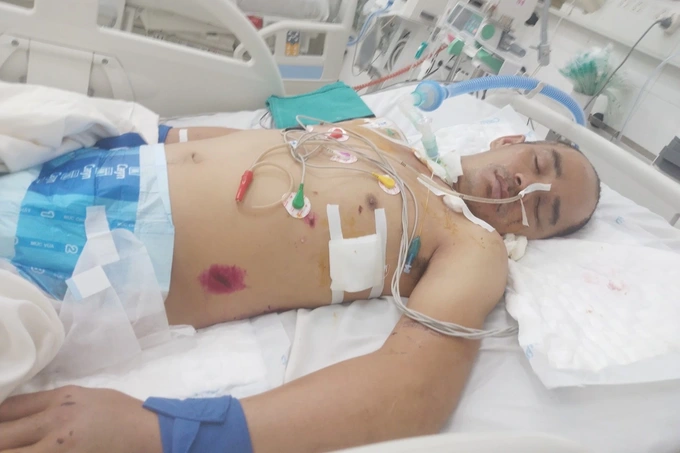EM – After an occupational accident on April 17th in Vinh Phuc, Viet lost consciousness he had fallen into an elevator shaft from the 5th floor, leading to multiple life threatening injuries: traumatic brain injury, broken bones, ribs, jaw fractures, kidney damage and pleural effusion.
Being aware of Mr. Do Cong Viet’s family hardships, oOn May 8th, the representative of the Vietnam Elevator Association, Mr. Nguyen Huy Tien – Vice Standing Chairman and Secretary-General of the Association visited and encouraged Mr. Viet at Viet Duc Hospital.
Mr Viet’s wife, Ms. Le Thi Trang, said that her husband had used to be an elevator mechanic at an elevator company in Thanh Hoa. Recently, he collaborated with two cousins, who work as freelancers, to install an elevator at a 14-floor construction project in Vinh Phuc. Unfortunately, on 17th, he suffered from an occupational accident and fell from the 5th floor of the building into the elevator shaft. The two cousins had left before the accident occurred “while he finished the work alone”.
Mr. Viet’s condition is currently very bad. As he fell from the 5th floor, he suffered multiple injuries: traumatic brain injury (with an organ being kept alive outside of the body), broken ribs, jaw, injured kidney and pleural effusion.

Mr. Viet had just undergone surgery for a traumatic brain injury, and is still in a coma (Photo: provided by the victim’s family)
The family circumstance is extremely difficult. Ms. Trang had borrowed 150 million dong for her husband’s brain surgery, unfortunately his condition has not been progressing and it is expected that there are going to be many more expenses to account for during the treatment process.
When the occupational accident occurred, what are the responsibilities of the involved parties?
Through discussions with Ms. Trang, the family has not treceived information on which construction project that Mr Viet was working at whether he was legally hired by a company or was he only working through acquaintances. Currently, the family is left to bear the treatment costs alone without any support.
In this incident, there are 2 unanswered issues: Who first received information about the occupational accident and transferred Mr. Viet to the hospital? And how do the relevant management departments intervene to protect the worker, investigate the cause of the incident and provide a warning and preventative plan?
According to Article 2 of the Law on Occupational safety and health, the umbrella term of employees includes employees working under labor contracts; probationers; apprentices, apprentices to work for employers and employees working without labor contracts. According to Article 38 of this Law, the employer’s responsibilities when an occupational accident occurs include:
1. To provide timely first aid and emergency care for employees getting occupational accidents, and make advance payment for first aid, emergency care and medical treatment for victims of occupational accidents or diseases;
2. To pay all medical expenses for first aid, emergency care and medical treatment for victims of occupational accidents or diseases until their health conditions become stable, specifically as follows:
a/ Co-payment expenses and expenses, which are not covered by health insurance for employees with health insurance;
b/ Expenses for medical assessment for determination the level of working capacity decrease for employees whose working capacity is concluded to have decreased by under 5% and who are recommended by the employer to a Medical Assessment Council for medical assessment to determine the level of working capacity decrease;
c/ All medical expenses for employees without health insurance.
3. To pay full salary to employees who get occupational accidents or diseases during their leave for medical treatment and working function rehabilitation;
Read more: Developing a national set of occupational skills standards is an urgent matter



